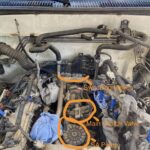Engine swaps can breathe new life into older vehicles, offering enhanced performance and capabilities. However, they can also introduce a range of challenges, particularly with vehicle diagnostics systems. A common hurdle encountered after swapping engines in a Chevy S10, specifically models around 2002, involves the OBD2 connector and its ability to communicate effectively with diagnostic tools. This article delves into the potential issues you might face with your 2002 OBD2 connector on an S10 post-engine swap, and offers insights into troubleshooting these problems to ensure your vehicle is running optimally and passes inspection.
One frequent issue reported by those undertaking engine swaps is the inability to establish a stable connection with the OBD2 port. Diagnostic scanners may fail to connect, disconnect intermittently, or report receiving unexpected data. This can be incredibly frustrating when trying to diagnose engine performance or clear fault codes, and critically, when attempting to pass vehicle inspections that rely on OBD2 system checks.
Several factors can contribute to OBD2 connection problems after an engine swap. Wiring discrepancies are a prime suspect. The original engine harness and ECU (Engine Control Unit) are designed for a specific engine and vehicle configuration. When swapping in a different engine, even within the same manufacturer’s family, the wiring may not perfectly align with the new ECU and engine sensors. This can lead to signal integrity issues, grounding problems, or power delivery fluctuations to the OBD2 connector.
In some cases, the issue might stem from the ECU itself. If the replacement engine comes with an ECU from a different vehicle model or year, the diagnostic protocols and monitor configurations may differ from what the inspection system or your scanner expects for a 2002 S10. For instance, an ECU from a full-size truck might include monitors for systems not present or expected in an S10, such as an EGR (Exhaust Gas Recirculation) system. This mismatch can confuse diagnostic tools and lead to communication errors or misinterpretations of the data.
Troubleshooting OBD2 connector issues on a 2002 S10 after an engine swap requires a systematic approach. A good first step is to verify the OBD2 connector wiring. Consulting wiring diagrams for both the original S10 and the donor vehicle is crucial. Ensure that the power, ground, and communication wires are correctly connected and that there are no breaks, shorts, or corrosion in the wiring. Directly wiring the OBD2 connector’s ground and power to the ECU’s ground and power sources, and the serial data line directly to the ECU, bypassing potentially problematic bulkhead connectors, can sometimes resolve signal integrity issues.
Comparing the emission monitors expected for a 2002 S10 with those reported by the swapped ECU can also provide valuable clues. Differences in the monitor list, as highlighted in the original scenario with the EGR system, can indicate an ECU mismatch that might be triggering flags during inspection. In such cases, exploring compatible ECUs, like the ‘411’ ECU from certain Silverado models which reportedly aligns with S10 monitor expectations, could be a viable solution.
While no DTCs (Diagnostic Trouble Codes) and completed readiness monitors are positive signs, they don’t guarantee OBD2 system compatibility, especially after a significant modification like an engine swap. The key is to ensure not only basic functionality but also data conformity expected by diagnostic and inspection systems for a 2002 Chevy S10.
Successfully navigating OBD2 connector challenges post-engine swap on a 2002 S10 often involves meticulous wiring verification, ECU compatibility checks, and a thorough understanding of the diagnostic protocols at play. By addressing these areas systematically, you can enhance the reliability of your OBD2 connection and ensure your modified S10 is ready for both the road and inspection.
